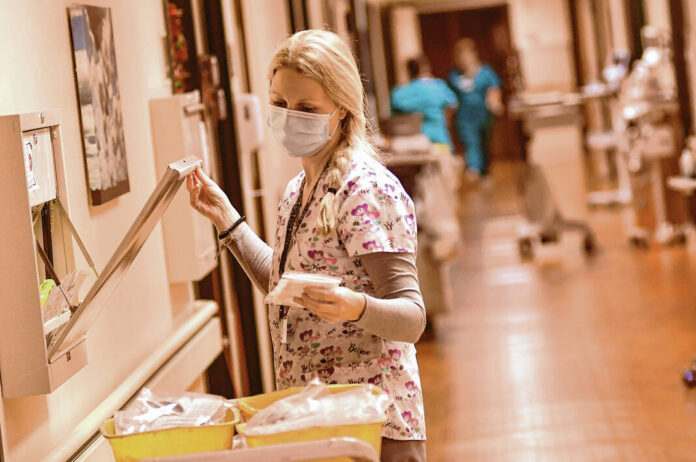
Joel Philippsen | CRH Photo Pharmacy Technician Carrie O’Sullivan restocks medications on 5 Tower at Columbus Regional Hospital Thursday afternoon, Dec. 16, 2021. O’Sullivan, who has worked at the hospital for 21 years, said that the high inpatient census has made her role busier with restocking medications on the patient floors.
Joel Philippsen | CRH Photo Pharmacy Technician Carrie O’Sullivan restocks medications on 5 Tower at Columbus Regional Hospital Thursday afternoon, Dec. 16, 2021.
LOCAL health officials say COVID-19 transmission remains high and hospitalizations have risen to double-digits for the first time in three months as an increasing number of Americans believe that the pandemic is over.
COVID-19 hospitalizations at Columbus Regional Hospital have risen into the double-digits at times over the past couple weeks for the first time since March.
On Wednesday, there were 12 people hospitalized at CRH with COVID-19, including one person in their 20s, the hospital said. Last week, a child was hospitalized with a coronavirus infection.
By comparison, COVID-19 hospitalizations had been hovering between zero and one during much of April and then between three and six from May 5 to 19 before starting to climb toward double-digits.
“We’re still in this,” said CRH spokeswoman Kelsey DeClue, referring to the coronavirus pandemic. “It’s still going.”
The update from the hospital system comes as the U.S. may be trudging into what could be another COVID-19 wave while more and more Americans believe the ongoing global health crisis is over and views on its trajectory continue to be split along political lines.
A Gallup poll released last month found that 34% of Americans — 1 in 3 — believe the pandemic is over in the United States, up from 18% in December.
A total of 66% of respondents who identified as Republicans — 2 in 3 — said the pandemic is over, compared to 39% of independents and 10% of Democrats.
Middle-aged Americans ages 45 to 64 are more likely than younger or older adults to hold the view that the pandemic has ended.
Yet an average of 29,099 people in the U.S. were hospitalized with COVID-19 as of Wednesday, a 12% increase over the past two weeks. ICU admissions were up 14%.
In Indiana, there were 498 people hospitalized with COVID-19 on Wednesday, up from 313 on May 21, according to the Indiana Department of Health.
And deaths continue to climb, with 41 Hoosiers dying from the virus during the past two weeks, state records show.
Locally, two Jackson County residents, two Shelby County residents, one Bartholomew County resident and one Johnson County resident have died from COVID-19 over the past month.
“We know that COVID-19 follows a different path than some other viral circulations,” DeClue said. “It obviously is not seasonal. It tends to go in almost a hills-and-valleys cycle almost year-round.”
“If we’re looking at the peaks and valleys, the cycle of this virus, those peaks are lasting pretty long,” DeClue added. “It’s not like a spike for a few days.”
CRH officials said that even when COVID-19 hospitalizations are low, “we know that’s not going to hold.”
New subvariant
Currently, another omicron “subvariant” — known as BA.2.12.1 — that scientists say may spread faster than its omicron predecessors and is adept at escaping immunity, is gaining ground in the U.S., recently becoming the dominant strain in the U.S., The Associated Press reported.
Federal health officials said in late April that they were “working to better understand BA.2.12.1, how it spreads and how well existing treatments and vaccines for COVID-19 work against it,” according to the Centers for Disease Control and Prevention.
Given the new subvariant and with “community spread as high as it is and lingering for as long as it is,” local health officials are urging people to “check their vaccination status” and get caught up on their shots. About 65% eligible Bartholomew County residents have received their first two doses of a COVID-19 vaccine, according to the CDC. Just half of local residents have received a booster shot.
“Now is the time to be looking at that and focusing on that,” DeClue said. “Don’t wait. Don’t say, ‘oh, you know, well, it’s summer and we’re outside’ because that’s not necessarily going to be a safety net for you.”
But as the pandemic drags on, CRH is expressing concern about Bartholomew County’s lagging vaccination and booster rates, the uncertainty over how the pandemic will evolve in the coming months and the “lingering, secondary effects” of the public health emergency — including its impact on mental health, fatigue and the consequences of putting off medical care for two years.
“There are concerns that we see and then those things that we don’t know that could be coming, another variant or a spike related to COVID-19,” DeClue said. “…We have to constantly be ready for the things that we can try to predict and look at in different parts of the nation, like we have in from the very beginning, but also be ready for the unexpected as well.”




